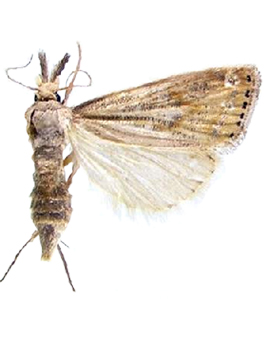Chilo partellus Swinhoe, [1885]; PED 5

-
Taxonomy
The holotype of Crambus partellus Swinhoe, 1885: 879 is from India (Bombay).
Syn. Crambus zonellus Swinhoe, 1884: 528, preocc. by Crambus zonellus Zeller 1847); Hampson 1896;
syn. Argyria lutulentalis Tams, 1932: 127 TL Malawi (Ft. Johnston) (syn. n. Martin, 1954: 120);
syn. Chilo zonellus Kapur, 1950;
syn. Diatraea calamina Hampson 1919: 544 (in part);
syn. Chilo partellus Bleszynski, 1965: , misapplied.
Comb. n. to Chilo (Bleszynski & Collins 1962: 243);
nec. syn. Crambus zonellus Zeller, 1847 TL Pakistan (Karachi)
nec. syn Jartheza simplex Butler, 1880 (Hampson 1896), missident. -
Description
Wing length: 7mm (male) and 17mm (female). Relatively small moths, females generally much larger than males. The FW is ochreous with a darker speckling and has a pleated appearance. The HW is pearly white with a faint black marginal line. This is another common pest species, widely misidentified.
Gupta (1940: 801, 806) illustrates wing venation, male genitalia and larva; Isaac & Venkatraman (1941: 810) described the larva & pupa; Kapur (1950: 399) figures the male & female genitalia and Rao & Nagaraja (1965) give detailed descriptions of all stages of Chilo auricilia, C. polychysa, C. suppressalis and C. partellus. Reported from Sabah (ARC Tuaran) but the specimen in Sabah (Tuaran ARC) possibly reported by Conway & Tay, (1968) is not this species (it is Angustalius malacelloides Bleszynski, 1955). -
Distribution & Habitat
Africa (E, S), Sudan, Pakistan, Sri Lanka, India (Comoro Is., Maharastra, Bihar, Uttar Pradesh, ), Nepal, Sabah?
-
Life History & Pest Status
The 'spotted stemborer'. In Nepal the egg, larval and pupal periods occur from April to September and lasted 4-5, 16-41 and 4-8 days, respectively. A complete generation took 28-48 days under summer conditions and 192-233 days from October to May (Neupane et al. 1985). C. partellus larvae feed in leaf funnels, causing characteristic scars and holes. They later feed at the growing point, which may be killed. The dead central leaves then form a characteristic 'dead-heart', especially in young plants. Older larvae tunnel extensively in stems and in maize cobs, weakening the stems, which may break and lodge; damage to inflorescences may interfere with grain formation, causing chaffy heads in sorghum. Similar symptoms are produced by other species of cereal stem borer.
-
Similar spp.
no content available.
-
Unrelated Look-alikes
no content available.
-
References
Conway, G. & Tay, E.B. (1968) Crop pests in Sabah, Malaysia and their control: With a provisional check list of insects and other animals of agricultural importance in Sabah. Kementerian Pertanian dan Perikanan Sabah, Malaysia [State Ministry of Agriculture & Fisheries (Sabah, Malaysia)].
Gupta, B.D. (1940) The anatomy, life and seasonal histories of striped moth borers of sugar cane in North Bihar and West United Provinces. Indian J. Agric. Sci., A, 10: 787-817.
Neupane, P.P., Coppel, H.C. & Chapman, R.C. (1985) Bionomics of the maize borer, Chilo partellus (Swinhoe), in Nepal, Int. J. Trop. Ins. Sci., 6 (4): 547-553.
Rao, V.P. & Nagaraja, H. (1965) A Comparative Study of the four species of paddy stem-borers belonging to the Genus Chilotraea and Chilo in Asia (Lepidoptera: Pyralidae: Crambinae, Proc. Indian Acad. Sci., 63: 175-217.
Swinhoe, C. (1884). On Lepidoptera collected at Kurgatchee. IV Heterocera. Proc. zool. Soc. Lond.: 503-529.
Swinhoe, C. ([1886], 1885). On the Lepidoptera of Bombay and the Deccan. Pt. II. Heterocera [continued]. Proc. zool. Soc. Lond.: 447-476. pl xxvii, xxviii. -
Genitalia
no content available.
-
DNA Barcode
no content available.
-
3D Imaging
no content available.
-
Spare
no content available.
KEY TO TABS
(1) Taxonomy, (2) Description, (3) Distribution & Habitat, (4) Life History & Pest Status, (5) Similar spp., (6) Unrelated Look-alikes, (7) References, (8) Genitalia, (9) DNA Barcode, (10) 3D Imaging, (11) Spare

